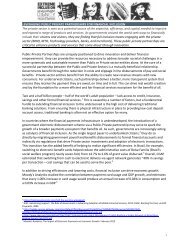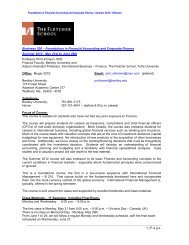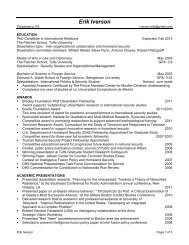A Case Study Analysis - Fletcher School of Law and Diplomacy
A Case Study Analysis - Fletcher School of Law and Diplomacy
A Case Study Analysis - Fletcher School of Law and Diplomacy
You also want an ePaper? Increase the reach of your titles
YUMPU automatically turns print PDFs into web optimized ePapers that Google loves.
4multiple policy objectives can lead to conflicting policies, harming the SWF’s ability to effectivelyachieve any single objective.Other external pressures <strong>and</strong> issues not related to economic policy can also lead governments to establishSWFs. Monk suggests that SWFs, particularly in the Middle East, are sometimes established tolegitimize local economic activity, as the SWF represents a modern institution that creates a financial linkwith the global economy (2010). Clark <strong>and</strong> Monk posit that in the Middle East, the establishment <strong>of</strong> aSWF can be driven by a desire to emulate neighboring governments <strong>and</strong> signal to neighbors <strong>and</strong> localelites that the country has reached modernity, <strong>and</strong> has achieved a position <strong>of</strong> importance in global finance(2011). Other scholars have suggested that local elites establish SWFs to maintain their grip on economicpower, <strong>and</strong> to pacify domestic <strong>and</strong> foreign adversaries (Hatton <strong>and</strong> Pistor 2011).Clearly, there are many motivations for governments to establish SWFs, from globally accepted economicpolicy objectives, propagated by multilateral institutions, to reasons based on political considerations, toother non-economic motives. The multitude <strong>of</strong> motivations for fund establishment, <strong>and</strong> available fundingbecause <strong>of</strong> imbalanced global capital flows, has led to a dramatic rise in the number <strong>of</strong> SWFs over thepast decade, particularly in frontier markets. Once the government decides to establish a SWF, the fund’sconstruction raises numerous policy <strong>and</strong> operational challenges which new funds must learn to manage,<strong>and</strong> <strong>of</strong>ten struggle to do so. In frontier markets, funds face numerous geographic challenges relating totheir location, access to human talent, <strong>and</strong> political environments, which the following section willdiscuss.Geographic Challenges“Geographic challenges” refers to the difficulties <strong>of</strong> operating a SWF in a place where the investmentmanagement industry is undeveloped, <strong>and</strong> far from current global centers <strong>of</strong> finance. While technologyhas enabled investors to overcome many significant barriers related to the flow <strong>of</strong> information (theinternet can convey market data just as quickly to Ulaanbaatar as to New York), geography nonethelesspresents significant challenges. In particular, SWFs in frontier markets must cope with geographicchallenges related to human capital, politics <strong>and</strong> operating processes.Human capital represents the most significant challenge faced by SWFs in frontier markets. A majorconsequence <strong>of</strong> geographic isolation is a lack <strong>of</strong> highly skilled pr<strong>of</strong>essionals necessary to manage theSWF, <strong>and</strong> to invest in the global markets to achieve the fund’s policy goals. Bachher <strong>and</strong> Monk (2012)identify a series <strong>of</strong> challenges faced by sovereign investors in frontier markets, including their status aspublic agencies with lower pay scales than private competitors, <strong>and</strong> locations in places with shallow or
















